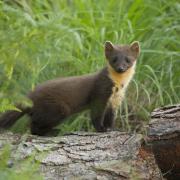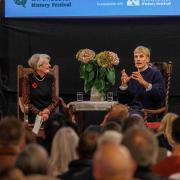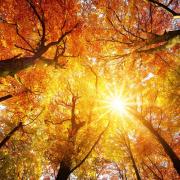From dressing to impress, to strutting your stuff on the dancefloor, there are plenty of approaches to catching the eye of a potential partner. For wildlife, finding a mate is a serious business, and animals invest a lot of energy in making the right match.
Sing it to win it
For centuries, would-be-suitors have serenaded their love interests. But birds have been doing it for even longer! Spring is famous for the explosion of sound as birds start to sing to establish territories, ward off rivals, and most importantly, attract a mate. The complexity of the song varies between species, but beauty is in the eye of the beholder. To a female chiffchaff, the male’s repetitive, two-note refrain is clearly more appealing than the mellifluous, flowing cascade of the similarly-coloured willow warbler.
Our most celebrated songbird must be the nightingale, though sadly his song is now missing from much of the UK. His verses are short, but his rich repertoire and flair for improvisation have earned the praise of poets and musicians throughout the ages.
Some birds are excellent mimics and may borrow sounds from the calls or songs of other species. You may have heard of the starling’s mastery of mimicry, copying the sounds of telephones, reversing lorries and even human speech, but did you know the common redstart is also a capable copycat? A study in Spain recorded a singing redstart and identified mimicry of over 50 different birds in less than an hour!
Birds may be our most well-known singers, but they aren’t the only animals to profess their interest through sound. Common frogs produce a chorus of soft, purring croaks – like the distant sound of revving motorbikes.

Flirty dancing
It’s not just the vocalists that put on a performance to pull the perfect partner. Whether it’s a tantalizing tango for two, a solo show that’s sure to stun, or even a groovy group number, dancing is everywhere in the animal kingdom.
The classic example is the great crested grebe. These birds are the epitome of elegance, with their long, slender necks, demure plumage, and black and orange crests fanned into a fabulous feather boa. Each spring, they take to the dance floor – well, lake’s surface – and deliver a dazzling display. The build-up involves braying calls, posturing, preening and synchronised head shaking, but it’s the showstopping finale that everyone’s here to see.
The two birds dive beneath the water, resurfacing with beaks brimming with weeds. They swim towards each other and, as they close the final few inches, rise from the water like a ballet dancer en pointe. Breast to breast they hold this rigid, vertical posture, their webbed feet paddling passionately to keep them upright. Throughout this dance, their heads swivel from side-to-side, as if searching for the judges’ scores – tens all-round, surely?
Grebes aren’t the only birds with brilliant moves. Mute swans use their long necks, bending and bobbing them in a slower, more stately dance, their heads sometimes coming together so that the elegant sweep of their necks forms a heart-shaped frame.
But it’s not just birds that perform a communal display, known as a lek, there are other animals that look to find love in a lek, including insects. Male ghost moths gather in the gloom of dusk, sweeping low over the vegetation in a pendulous display flight, as if tethered to the end of an invisible string. Their pale wings catch what little light remains so that they may also catch the attention of attending females. They further enhance their appeal by releasing pheromones as they dance, for a perfect, perfumed performance.

Gifts of love
When a male scorpion fly approaches a female, he presents her with a gift – a box of chocolate perhaps, or some nice flowers? No, he offers a dead insect (sometimes scavenged from a spider’s web), or a ball of his own spit, for the female to eat. A welcome nutritional boost to invest in egg production!
Many species offer gifts of food to their partner – often it’s a profession of their prowess as a hunter, proof that they can provide for their offspring; or simply to make sure the female has all the calories she needs to produce healthy eggs or young. Some gifts may come with ulterior motives. There’s research to suggest that female scorpion flies that receive larger gifts may be less likely to go on to mate with another male!
These are a just a few examples of the singing, dancing, and gift-giving animals we’re lucky enough to have in the UK. When it comes to wild wooing, there’s a whole world of weird and wonderful strategies out there to discover! Parts of the Cotswold Water Park are a fantastic place to see great crested grebes performing during March, particularly Roundhouse Lake and Whelford Pools nature reserves, which also see the occasional nightingales from April onwards. Redstarts can be seen in the south-western areas of the Cotswolds, and have been spotted near Cheltenham in previous years, but are a rare sight! Two species you’re more likely to see are chiffchaffs and scorpion flies, which live in woodlands, gardens and hedgerows – you might see or hear them at Crickley Hill, near Cheltenham.

Cotswold great – Comma butterfly
The comma is one of the few butterflies that overwinters as an adult, the rough edges and leaf-like colouring of the wings help to camouflage the butterflies among dead leaves, where they hibernate.
The comma is among the first butterflies to be seen each year on warm winter days, before emerging fully in March. It’s often close behind red admiral, peacock, and small tortoiseshell butterflies, who also spend their winter as adults.
Look out for ragged, orange wings with brown spots, as well as small, white, comma-shaped spots on the wings’ underside, which give the comma its name. As caterpillars, they feed on common nettles, elms, and willows, and with their camouflaging brown and white flecks, they could be mistaken for bird droppings!
In the 20th century, the comma faced a severe decline, but today they are one of the few butterfly species to be increasing their distribution, potentially due to the effects of a changing climate.

Signs of spring
- Overwintering butterflies, like red admirals, begin to emerge on warm and sunny days.
- Spring flowers like wood anemone and wild daffodil begin to appear, adding colour to woodlands and feeding emerging pollinators.
- Birds like long-tailed tits and rooks begin to make and patch up their nests, ready to lay eggs.
- Hazel catkins, the yellow, dangling, male flowers of hazel trees, start to appear on branches.
- The first leaves start to emerge from buds on trees like alder, silver birch, and field maple.
- Frogspawn starts to appear in ponds, which will soon turn into tadpoles.
Did you know?
Most daffodils we see are garden varieties, but wild daffodils can be spotted among ancient woodland or damp meadows. Once abundant and hand-picked for markets, this wildflower is now much rarer, having declined during the 19th century, but can be seen in parts of Gloucestershire.

Gardening
Making a pond is a great way to invite more wildlife into your garden, especially snail and slug-eating amphibians like frogs.
No matter how big or small, ponds help all kinds of wildlife, including birds, insects, amphibians and mammals, just make sure to include a ramp or slope so that mammals like hedgehogs can escape if they fall in whilst having a drink.
When building your pond, make sure to include a mixture of plants, including oxygenating plants which release oxygen into water throughout the day. These plants help to create a natural equilibrium in the pond and keep the growth of algae under control.
For more information on how to build a pond, head to gloucestershirewildlifetrust.co.uk/actions



























